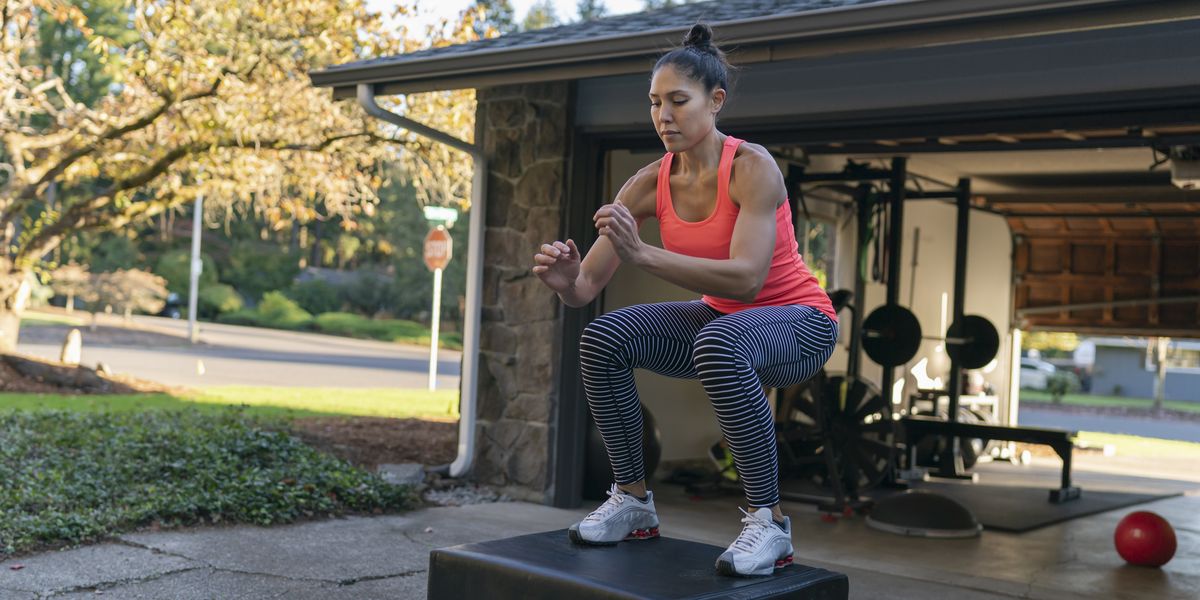I recently wrote about how running with a can of Pringles helped me improve my form—an ingenious trick from my high school coach that taught me to keep my hands relaxed. The story got me thinking: What other out-of-the-box methods did he use to make me a better runner?
The answer popped up when I was scrolling through Runner’s World’s brand-new Guide to Strength Training, which includes a plyometrics follow-along workout that instantly brought me back to my high school days. I remembered how my coach had us add one simple, power-driven exercise to the end of at least one training run per week: box jumps.
Once or twice a week, my teammates and I ended our 55-minute easy runs with box jump reps. However, it wasn’t as straightforward as doing a few sets. We’d head over to the green wooden boxes in the corner of our high school’s track stadium to do 10 jumps, and then followed it up with a lap around the track. Repeat that four times, and we had 40 box jumps and a mile of running under our belts to finish off our session for the day.
Honestly, I didn’t look forward to box jump days. Who wants to add tiring exercises to the end of a run and log an extra mile? I didn’t realize until much later that by adding consistent plyometrics to our weekly training, our coach helped us build speed and power that translated to races. I’m sure it played a role in helping me consistently run strong in the 800 meters and 1,600 meters at the state level–and even earn a spot on our state runner-up 4×400-meter relay team.
Related Stories
As Winnie Yu, D.P.T., C.S.C.S., a physical therapist and strength coach at Bespoke Treatments in New York City, explains in Runner’s World’s Guide to Strength Training, a routine that includes heavy lifting and plyometric exercises can improve your ability to go faster for longer.
“Research shows that lifting heavy weight for fewer reps is one of the best strength training methods to improve running economy, along with plyometrics or explosive movements like squat jumps, box jumps, or jumping lunges,” Yu says in the program.
But the benefits of plyometrics go beyond running economy improvement. You’ll increase power to help you develop a scorching finishing kick, as well as strengthen weak glutes and calves. Plus, consistent plyometric work will help you confidently conquer hill climbs.
You can add plyometric movements to your strength training regimen with ease by following the total-body with plyometrics workout featured in our Guide to Strength Training. Yu and Deputy Health & Fitness Editor Mallory Creveling walk you through a 30-minute workout with core exercises, single-leg movements, and explosive moves meant to target major muscle groups and build power and stability.
You can also diversify your training with five additional follow-along workouts featured in the program that focus on everything from upper-body strength to glute activation.
Want even more ways to level up your training? Become a Runner’s World+ member today to gain access to exclusive, expert-led programs aimed at helping you reach your goals, from beginning your running journey to racing a marathon.
Ashley is Editor of Content Hype at Hearst’s Enthusiast & Wellness Group. She is a former collegiate runner at UNC Asheville where she studied mass communication. Ashley loves all things running; she has raced two marathons, plus has covered some of the sport’s top events in her career, including the Paris Olympics, U.S. Olympic Trials and multiple World Marathon Majors.

